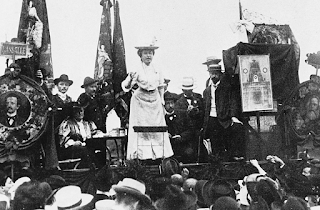Kurt
Tucholsky, born in Berlin into a Jewish family, was one of the most
famous writers, journalists, and satirists of the Weimar Republic. 85
years ago today, he took his own life in Swedish exile where he had fled
to in 1932 already.
He knew what was coming.
Without an audience, or influence, too depressed to write, and out of
money, he overdosed on sleeping pills. His then-girlfriend Gertrude
Meyer — or rather, one of his two girlfriends — found him. He was rushed
to the hospital where he died the next day. He left three letters to his
girlfriends and to his second wife, Mary Gerold, whom he made his sole
heir. It was Mary who resurrected his work after 1945.
Tucholsky was a tragic, contradictory figure; very gifted, a brilliant
writer, liked by his friends, hated by the ones he trashed
mercilessly, funny and entertaining, well-read and well-traveled. But he
had trouble staying in a longer relationship. Both of his marriages —
and quite a few courtships before, during, and after them — ended in
divorce. He loved France where he lived for years, but France would not
take him in after the Nazis came to power.
He did not pledge alliance to any party. He flirted with Communism, but
was never willing to toe the party line. He wore fine suits and liked to
dine well. He spent most his life criticizing the Social Democrats. He
belittled the Conservatives and he despised the Nazis. Naturally, he was
among the first ten authors whose books were burned in 1933 at the
Opernplatz in Berlin, together with Karl Marx and Sigmund Freud.
Here is a story from the book Hereafter, where Tucholsky muses about the afterlife.
“I Did Not Pass away without a Trace. Except—”
What time …?”—but his hand was already flopping back down. “Oh,” he said. I smiled. When I noticed the expression in his eyes, I straightened my laugh lines again.
“No time,” he whispered. “Still getting used to the fact that there’s no time anymore. Yes, the good old apriorist … ”
I diverged. “Down there, did you picture time geometrically too?” I asked.
“No, how … ?” he said.
“Like you were living forward in space,” I replied. “Like you could slide back and forth in space-time, forward and backward, playing with everything in space: when someone appears back there, he’s small; when he comes toward us, he gets bigger, and then his form diminishes, disappears—you know?”
“Not really,” he said.
“No?” I asked. “It’s like this:
“The little house I used to live in is standing still. Now it starts moving. At night, when we can’t sleep, we can hear what it’s doing. It’s traveling through time. It’s moving forward so fast that the water of time froths up high in front, off its bow; the house splits time, which flows to the right and left of it, whooshing by all around, and we’re lying in our little bedrooms, carried along, helpless, powerless, ever onward. Now and then a hand slides off the bed, dangling limply, and moving—backward? There is no backward. Sometimes the sleeper flinches in the face of what’s yet to come—but it’s all riding along with him. Premonitions don’t help. When you wake up early in the morning, the house has already stopped somewhere else.”
“Yeah, I did feel something like that,” he said. “No one’s very happy about it though.”
“No,” I said. “No one’s very happy about it. In the end, you’re left with the vague sensation of a host of impressions; it would be fun if you could hit fast-forward and the whole life you’re doomed to live came thundering down all at once. But you couldn’t do that.”
“Did you long to … to come here?” he asked.
“Often,” I said. “I was hungry every livelong day. Hungry for money, then hungry for women, then, when that subsided, hungry for stillness. So hungry for tranquility. And more: hungry for completion. Not having to—not having to travel through time.”
“You pass away without a trace,” he said.
“No,” I said, “you don’t pass away without a trace. No, I’m not talking about monuments—that’s ridiculous. And I know what you’re about to say: immortal works. Please … No, something else. I left something there—yes, I did leave something there.”
“What?” he asked, somewhat ironically.
“I left something for the things,” I said. “Since that day when I saw the ancient piano player in Paris, who my father had seen twenty years earlier in Cologne. He was still playing the same pieces, that wandering virtuoso—the very same ones. And I felt like my dead father was speaking through him. And I told the things something as well. I sent my regards through many things that have endured longer than you and I. I attached a greeting here and a wreath there, a curse here and a defensive silence there … and as I did, I noticed that the things were already full of similar greetings from those who had passed away. Almost every one of them had held onto matter, left traces behind; when you roamed by, pleas, supplications, curses, and blessings rained down from those things that people say are dead. I did not pass away without a trace. Except—”
“Except what?” he asked.
“Except people are illiterate,” I said, “They can’t read it.”
He looked at me and touched the place where his wristwatch used to be. “Come on,” he said, “Let’s go have that afternoon coffee.”
Die Weltbühne, January 19, 1926
Hereafter
Author: Kurt Tucholsky
Translator: Cindy OpitzPreface: William Grimes
Hardcover, 96 pages, 25 Photos
Genre: Short Stories
Dimensions: 5'' x 8''
ISBN: 978-1-935902-89-8
Suggested Retail $14.95 / 12,00 €











